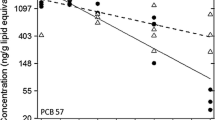Abstract
Patterns of chlorinated biphenyl (CB) congeners have been compared in two groups of samples, namely blood samples from harbor seals (Phoca vitulina) and muscle tissue samples in the fish with which the seals were fed. The data originate from a Dutch controlled feeding study, performed in 1981 and 1983. The seals were living in captivity in two separate groups, and the fish samples were plaice (Pleuronectes platessa) from the Dutch part of the Wadden sea and mackerel (Scomber scombrus) from the Atlantic ocean. The levels of CB congeners were different in the two types of fish.
The CB congener patterns of these four “matrices” were compared by analysis of principal components, and were found to be different in the two groups of harbor seals, which were fed the different types of fish. The corresponding CB congener patterns of the two groups of fish were also different.
There was no indication for a relatively larger impact of biotransformation due to induction of isoforms of the cytochrome P450-system at the higher absolute CB congener levels in the Wadden sea group of seals compared to the Atlantic group of seals. The differentiation between the CB congener patterns in the two groups of seals in the Dutch study can be ascribed solely to different CB congener patterns in their food.
The difference between CB congener patterns in the seals and in their diet can be explained by the structure-related biotransformation of the CB congeners in the harbor seal.
Similar content being viewed by others
References
Boon JP, Reijnders PJH, Dols J, Wensvoort P, Hillebrand MTJ (1987) The kinetics of individual polychlorinated biphenyl congeners in female harbour seals (Phoca vitulina), with evidence for structure related metabolism. Aquat Toxicol 10:307–324
Boon JP, Oostingh I, Meer Jvd, Hillebrand MTJ (1994) A model for the bioaccumulation of chlorobiphenyl congeners in marine mammals. Eur J Pharmacol 270:237–251
Boon JP, Eijgenraam F, Everaarts JM, Duinker J (1989): A Structureactivity relationship (SAR) approach towards metabolism of PCBs in marine animals from different trophic levels. Mar Environ Res 27:159–176
Boon JP, van Arnhem E, Jansen S, Kannan N, Petrick G, Schulz D, Duinker JC, Reijnders PJH (1992) The toxicokinetics of PCBs in marine mammals with special reference to possible interactions of individual congeners with cytochrome P450-dependent monooxygenase system: An overview. In: Walker CH, Livingstone DR (eds) Persistent pollutants in marine ecosystems Pergamon Press, pp 119–159
Gonzalez M J, Fernandez M A, Hernandez L M (1991) Levels of chlorinated insecticides, total PCBs, and PCB congeners in Spanish Gull eggs. Arch Environ Contam Toxicol 20:343–348
Hansen LG (1987) Food chain modification of the composition and toxicity of polychlorinated biphenyl (PCB) residues. Rev Environ Contam Toxicol 3:149–212
Larsen B, Riego J (1990) Interference from 2,3,5,6,3′,4′-hexachlorobiphenyl (CB-163) in the determination of 2,3,4,2′,4′,5′-hexachlorobiphenyl (CB-138) in environmental and technical samples. Intern J Environ Anal Chem 40:59–68
MacDonald CR, Norstrom RJ, Turle R (1992) Application of pattern recognition techniques to assessment of biomagnification and sources of polychlorinated multicomponent pollutants, such as PCBs, PCDDs and PCDFs. Chemosphere 25(1):129–134
Morrison D F (1976) Multivariate statistical methods. McGraw-Hill, NY
Norstrom RJ, Muir DCG, Ford CA, Simon M, MacDonald CR, Béland P (1992) Indications of P450 monooygenase activities in beluga (Delphinapterus leucas) and Narwhal (Monodon monoceros) from patterns of PCB, PCDD, and PCDF accumulation. Mar Environ Res 34:267–272
Reijnders PJH (1986) Reproductive failure in harbour seals feeding on fish from polluted coastal waters. Nature 324:456–457
Schwartz TR, Stalling DL (1991) Chemometric comparison of polychlorinated biphenyl residues and toxicologically active polychlorinated biphenyl congeners in the eggs of Forster's Terns (Sterna forsteri). Arch Environ Contam Toxicol 20:183–199
Storr-Hansen E, Spliid H (1993a) Coplanar polychlorinated biphenyl congener levels and patterns and the identification of separate populations of Harbour seals (Phoca vitulina) in Denmark. Arch Environ Contam Toxicol 24:44–58
— (1993b) Distribution patterns of polychlorinated biphenyl (CB) congeners in harbor seal (Phoca vitulina) tissues: Statistical analysis. Arch Environ Contamin Toxicol 25(3):328–345
Zitko V (1989) Characterization of PCBs by principal component analysis. Mar Pollut Bull 20(1):26–27
Author information
Authors and Affiliations
Rights and permissions
About this article
Cite this article
Storr-Hansen, E., Spliid, H. & Boon, J.P. Patterns of chlorinated biphenyl congeners in harbor seals (Phoca vitulina) and in their food: Statistical analysis. Arch. Environ. Contam. Toxicol. 28, 48–54 (1995). https://doi.org/10.1007/BF00213968
Received:
Revised:
Issue Date:
DOI: https://doi.org/10.1007/BF00213968




